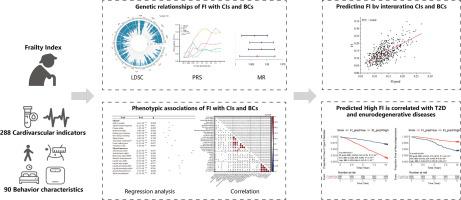当前位置:
X-MOL 学术
›
J. Adv. Res.
›
论文详情
Our official English website, www.x-mol.net, welcomes your feedback! (Note: you will need to create a separate account there.)
Genetic and phenotypic associations of frailty with cardiovascular indicators and behavioral characteristics
Journal of Advanced Research ( IF 11.4 ) Pub Date : 2024-06-09 , DOI: 10.1016/j.jare.2024.06.012 Yihan Chen , Siying Lin , Shuangyu Yang , Mengling Qi , Yu Ren , Chong Tian , Shitian Wang , Yuedong Yang , Jianzhao Gao , Huiying Zhao
Journal of Advanced Research ( IF 11.4 ) Pub Date : 2024-06-09 , DOI: 10.1016/j.jare.2024.06.012 Yihan Chen , Siying Lin , Shuangyu Yang , Mengling Qi , Yu Ren , Chong Tian , Shitian Wang , Yuedong Yang , Jianzhao Gao , Huiying Zhao

|
Frailty Index (FI) is a common measure of frailty, which has been advocated as a routine clinical test by many guidelines. The genetic and phenotypic relationships of FI with cardiovascular indicators (CIs) and behavioral characteristics (BCs) are unclear, which has hampered ability to monitor FI using easily collected data. This study is designed to investigate the genetic and phenotypic associations of frailty with CIs and BCs, and further to construct a model to predict FI. Genetic relationships of FI with 288 CIs and 90 BCs were assessed by the cross-trait LD score regression (LDSC) and Mendelian randomization (MR). The phenotypic data of these CIs and BCs were integrated with a machine-learning model to predict FI of individuals in UK-biobank. The relationships of the predicted FI with risks of type 2 diabetes (T2D) and neurodegenerative diseases were tested by the Kaplan-Meier estimator and Cox proportional hazards model MR revealed putative causal effects of seven CIs and eight BCs on FI. These CIs and BCs were integrated to establish a model for predicting FI. The predicted FI is significantly correlated with the observed FI (Pearson correlation coefficient = 0.660, P-value = 4.96 × 10). The prediction model indicated “usual walking pace” contributes the most to prediction. Patients who were predicted with high FI are in significantly higher risk of T2D (HR = 2.635, < 2 × 10) and neurodegenerative diseases (HR = 2.307, = 1.62 × 10) than other patients. This study supports associations of FI with CIs and BCs from genetic and phenotypic perspectives. The model that is developed by integrating easily collected CIs and BCs data in predicting FI has the potential to monitor disease risk.
中文翻译:

衰弱与心血管指标和行为特征的遗传和表型关联
衰弱指数(FI)是衡量衰弱程度的常用指标,许多指南都提倡将其作为常规临床测试。 FI 与心血管指标 (CI) 和行为特征 (BC) 的遗传和表型关系尚不清楚,这阻碍了使用易于收集的数据监测 FI 的能力。本研究旨在调查衰弱与 CI 和 BC 的遗传和表型关联,并进一步构建预测 FI 的模型。通过跨性状 LD 评分回归 (LDSC) 和孟德尔随机化 (MR) 评估 FI 与 288 个 CI 和 90 个 BC 的遗传关系。这些 CI 和 BC 的表型数据与机器学习模型相结合,以预测英国生物库中个体的 FI。通过 Kaplan-Meier 估计器和 Cox 比例风险模型 MR 测试了预测的 FI 与 2 型糖尿病 (T2D) 和神经退行性疾病风险的关系,揭示了 7 个 CI 和 8 个 BC 对 FI 的假定因果影响。这些 CI 和 BC 被整合以建立预测 FI 的模型。预测的 FI 与观察到的 FI 显着相关(Pearson 相关系数 = 0.660,P 值 = 4.96 × 10)。预测模型表明“通常的步行速度”对预测的贡献最大。预测为高 FI 的患者患 T2D (HR = 2.635, < 2 × 10) 和神经退行性疾病 (HR = 2.307, = 1.62 × 10) 的风险显着高于其他患者。这项研究从遗传和表型的角度支持 FI 与 CI 和 BC 的关联。通过集成轻松收集的 CI 和 BC 数据来预测 FI,开发的模型具有监测疾病风险的潜力。
更新日期:2024-06-09
中文翻译:

衰弱与心血管指标和行为特征的遗传和表型关联
衰弱指数(FI)是衡量衰弱程度的常用指标,许多指南都提倡将其作为常规临床测试。 FI 与心血管指标 (CI) 和行为特征 (BC) 的遗传和表型关系尚不清楚,这阻碍了使用易于收集的数据监测 FI 的能力。本研究旨在调查衰弱与 CI 和 BC 的遗传和表型关联,并进一步构建预测 FI 的模型。通过跨性状 LD 评分回归 (LDSC) 和孟德尔随机化 (MR) 评估 FI 与 288 个 CI 和 90 个 BC 的遗传关系。这些 CI 和 BC 的表型数据与机器学习模型相结合,以预测英国生物库中个体的 FI。通过 Kaplan-Meier 估计器和 Cox 比例风险模型 MR 测试了预测的 FI 与 2 型糖尿病 (T2D) 和神经退行性疾病风险的关系,揭示了 7 个 CI 和 8 个 BC 对 FI 的假定因果影响。这些 CI 和 BC 被整合以建立预测 FI 的模型。预测的 FI 与观察到的 FI 显着相关(Pearson 相关系数 = 0.660,P 值 = 4.96 × 10)。预测模型表明“通常的步行速度”对预测的贡献最大。预测为高 FI 的患者患 T2D (HR = 2.635, < 2 × 10) 和神经退行性疾病 (HR = 2.307, = 1.62 × 10) 的风险显着高于其他患者。这项研究从遗传和表型的角度支持 FI 与 CI 和 BC 的关联。通过集成轻松收集的 CI 和 BC 数据来预测 FI,开发的模型具有监测疾病风险的潜力。











































 京公网安备 11010802027423号
京公网安备 11010802027423号